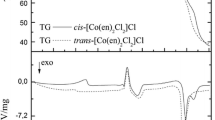Abstract
The decomposition of aluminium chloride hexahydrate was examined in the temperature range 400– 1000° by means of differential thermal analysis and thermogravimetric methods in combination with evolved gas analysis (mass spectra and thermogas-titrimetric methods). In the course of non-isothermal decomposition from 200to 780° it was found that there is a relative Cl−-stabilization in the Cl−- and OH−-containing amorphous product. This amorphous product gives rise abruptly toγ A12O3 at 780° in a lattice rearrangement process. A decrease of mass is associated with this process, which depends upon the splitting-off of HCl and AlCl3·H2O and HCl from the gas phase decrease the activation energy of the lattice rearrangement process, and displace this process toward lower temperatures.
Résumé
On a mis au point, par analyse thermique différentielle et thermogravimétrie en combinaison avec des méthodes de l'analyse des gaz (spectrométrie des masses et titrimétrie thermique des gaz) la décomposition de AlCl3 · 6 H2O dans l'intervalle de températures entre 400 et 1000°. Lors de la décomposition dans l'étape de réaction non-isotherme entre 200 et 780° il se produit une stabilisation relative de Cl− dans le produit de décomposition amorphe à teneurs en Cl− et OH−. Celui forme à 780° brusquement, dans un procès d'ordonnement de grille, duγ-Al2O3. Liée à ce procès est une perte de masse basant sur le détachement de HC1 et d'AlCl3 · H2O et HCl de la phase gazeuse baissent l'énergie d'activation du procès d'ordonnement de grille et le déplacent vers les températures plus faibles.
Zusammenfassung
Die Zersetzung von AlCl3 · 6 H2O wurde im Gebiet 400 bis 1000° mittels Differentialthermoanalyse und Thermogravimetrie in Kombination mit Methoden der Gasanalyse (Massenspektrometrie und Thermogastitrimetrie) untersucht. Während der Zersetzung im nichtisothermen Reaktionsschritt von 200 bis 780° kommt es zu einer relativen Cl−-Stabilisierung im Cl−- und OH−-haltigen amorphen Abbauprodukt. Dieses bildet bei 780° sprunghaft in einem Gitterordnungsprozeßγ-Al2O3. Mit diesem Vorgang ist eine Masseabgabe verbunden, die auf der Abspaltung von HCl und AlCl3 beruht. H2O und HC1 aus der Gasphase senken die Aktivierungsenergie des Gitterordnungsprozesses und verschieben diesen nach niedrigeren Temperaturen.
Резюме
Исследовано разложе ние гексагидрата хлористого алюминия в области температур 400–1000°, используя диффер енциальный термичес кий анализ и терногравиметриче ские методы в комбинации с анализом выделенног о газа (масс-спектрометриче ский и термогазотитриметр ический метод). В ходе р еакции неизотермического р азложения от 200 до 780° было обнаружено, что там происходит относительная стаби лизация Cl− в аморфном продукте, со держащем Cl− и OH−. Этот аморфный продукт при 780° резко превращается боγ-Al2O3 в процессе перегруппи ровки решетки. Этот процесс сопровождается уменьшением массы, чт о связано с расщеплен ием НСl и AlCl3. Вода и хлористый водород их газовой фа зы уменьшают энергию активации процесса решеточной перегруппировки и смещают этот процес с к более низким темпе ратурам.
Similar content being viewed by others
Literatur
R. Naumann, D. Petzold, F. Paulik undJ. Paulik, J. Thermal Anal., 15 (1979) 47.
D. Petzold undR. Naumann, Freiberger Forschungshefte, A 616 (1979) 75.
W. Biltz, A. Lemke undK. Meisel, Z. Anorg. Allg. Chem., 186 (1930) 373.
T.Sato, F.Ozawa, H.Terada und S.Ikoma, Proceedings of the Fifth International Conference on Thermal Analysis, Japan, Kyoto, 1977, S. 269–272.
N. M. Drobot undE. I. Khazanow, Izv. Nauk. Issled. Inst. Nefte-Uglechim., 11 (1969) 111.
A. Horecka undJ. Kulik, Zeszyty Nauk. Politech. Slask Chem., 39 (1967) 149.
R. Kieffer undO. Heimke, Sprechsaal, 106 (1973) 465.
H. Breuil, Ann. Chim., 10 (1965) 467.
N. M. Drobot, K. G. Ione undN. E. Bujanowa, Kinetikai Kataliz, 11 (1970) 1537.
F. Paulik undJ. Paulik, J. Thermal Anal., 5 (1973) 253.
F. Paulik undJ. Paulik, J. Thermal Anal., 8 (1975) 557.
F. Paulik undJ. Paulik, Analyst, 103 (1978) 417.
D.Petzold, W.Hopf und G.Lautenschläger, DDR-Wirtschaftspatent, 130 656, Int. Cl 2 (51) C 01 F 7/58 vom 18.4.1977.
K. Wefers undG. M. Bell, Oxides and Hydroxides of Aluminium, Technical Paper Nr. 19, ALCOA Res. Lab., East. St. Louis/III., USA, 1972.
M. J.Ruthner und H.Krischner, Bericht über den 3. Kongreß der ICSOBA Nizza, 1973, S. 547–555,
Author information
Authors and Affiliations
Rights and permissions
About this article
Cite this article
Petzold, D., Naumann, R. Thermoanalytische Untersuchungen zur Bildung kristalliner A12O3-Formen bei der thermischen Zersetzung von Aluminiumchloridhexahydrat. Journal of Thermal Analysis 20, 71–86 (1981). https://doi.org/10.1007/BF01912998
Received:
Issue Date:
DOI: https://doi.org/10.1007/BF01912998




